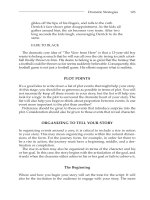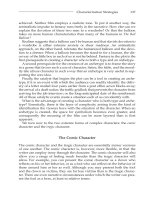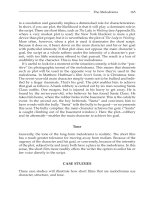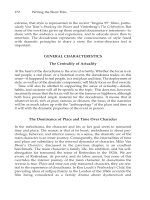Tài liệu Writing the short film 3th - Part 29 doc
Bạn đang xem bản rút gọn của tài liệu. Xem và tải ngay bản đầy đủ của tài liệu tại đây (144.61 KB, 7 trang )
Ch14.qxd 9/27/04 6:10 PM Page 186
15
THE HYPERDRAMA
Hyperdrama is in many ways far from both melodrama and docudrama.
Although it maintains the basic structural elements and places a conflictual
main character against a plot, hyperdrama is the opposite of the tonal real-
ism and factual realism so central to the other two meta-genres. In this sense,
excessive exaggeration and fantasy are both key ingredients of the hyper-
drama. Although the analogy to the fairy tale is too restrictive, the parallels
are there—the predominance of elemental moral struggle. In “Little Red
Riding Hood,” the danger is known, the wolf, and the moral struggle con-
cerns respect for one’s elders. How different is the story in the Star Wars tril-
ogy, where respect for one’s elders is modernized? In the trilogy, the ultimate
elder, the father, no longer deserves respect. What is a child, in this case a
son, to do?
Although particular filmmakers have been affiliated with hyperdrama—
Luis Buñuel throughout his career, from Spain to Mexico to France—the
genre is more often affiliated with humorists, such as Charlie Chaplin and
the Marx Brothers. Modern Times (1936) is a fable about industrialization and
its explicit tendency to mechanize and dehumanize. The many set-pieces in
the film have an internal logic, but they are so fabulist in their content that
realism is actually beside the point. A similar quality infuses the majority of
Chaplin’s work.
At the other extreme, the films of the Marx Brothers dwell on the anarchy
that befalls characters beset by life problems—making a living, getting
along, organizing action toward a goal. All the characters’ goals are sub-
verted by the anarchy that allows individual will to reign supreme. In the
Marx Brothers’ films, such as Duck Soup, the truly moral thing to do is take
care of yourself at the expense of others—a modern moral interpretation that
has made their films popular to this day.
187
Ch15.qxd 9/27/04 6:11 PM Page 187
Hyperdrama seems to have taken on new life since Star Wars. Although
filmmakers from the past like Fellini occasionally drifted into hyperdrama
(Satyricon), today there are numerous filmmakers whose careers are associ-
ated with it. They are notable filmmakers, too—Werner Herzog (Aguirre,
Wrath of God), Steven Spielberg (E.T.), Stanley Kubrick (A Clockwork Orange),
Robert Zemeckis (Forrest Gump), Emir Kusturica (Underground), Neil Jordan
(Butcher Boy), and Lars Von Trier (Breaking the Waves). What is also notable is
that particular genres—the action-adventure film, the horror film, and the
melodrama—are all amended in hyperdrama to incorporate, above all, a
moral lesson, which has been powerfully embraced by audiences. In order
to understand why, we now turn to the general characteristics that distin-
guish hyperdrama from other genres.
GENERAL CHARACTERISTICS
The Centrality of the Moral Lesson
At its heart, hyperdrama is a story told in service of a moral lesson. Character,
plot, tone, all serve that overriding purpose. The moral lesson might be
focused on personal behavior, for example. The main character in Buñuel’s
The Criminal Mind of Archibald Cruz is convinced that he committed a crime
(murder) as a child. We know that he did not. However, he conducts his life
and relationships in an aura of guilt and in the expectation that if he becomes
too close to anyone, in a love relationship for example, he will again become
a murderer. The moral lesson of Buñuel’s film is that we are all prisoners of
our childhood experiences, whether they are negative or positive. How use-
ful or not this imprisonment is goes to the core of Buñuel’s goal in this film.
The moral lesson can be driven by social or community standards, as in the
case of Zemeckis’s Forrest Gump. By community standards, Forrest Gump is
slow intellectually, and does not quite comprehend events around him. He
passes through the Hippie Revolution, the Vietnam War, the political
upheavals of the 1970s, and the rising hopes of the 1980s in America. All the
while he is a constant—running toward or away from his peers, ingenuous, a
Candide in a shark-infested society. In his naiveté, in his faith in people, and
in his constancy he actually becomes “the one good person” who can change
the lives of others. Here the moral lesson is that communities sometimes are
too quick to label their members and thereby limit them and their contribu-
tions. The moral lesson is to back away from labeling and limiting.
The moral lesson can also be driven by political goals. The young boy who
decides to stop growing, as a political protest to Nazism, in Volker
Schlondorff’s The Tin Drum, is making a political statement. The immorality
of the regime and its influence on personal codes of conduct is so pervasive
188 Writing the Short Film
Ch15.qxd 9/27/04 6:11 PM Page 188
that the young boy’s moral decision about his own physical stature is both
pragmatic and metaphorical. The ideology of Nazism, with its racism and its
celebration of Aryanism, is visually assaulted by the main character’s
stature. He is German, he is imperfect, and yet more moral than his peers.
The engine at the heart of the hyperdrama is the moral lesson. This qual-
ity distinguishes the form from other genres.
Realism Is Not Important
Although moral tales can be presented realistically, if hyperdrama is to be
dramatically acceptable, realism actually gets in the way. Perhaps a more
inclusive description of hyperdrama requires that the fantastic, positive or
negative, be integral to the genre. This might mean the monster within, as in
John Frankenheimer’s Seconds; it might mean the existence of magic, as in
John Boorman’s Excalibur. It certainly embraces the active imagination, as in
Jean Claude Lauzon’s Leolo and Victor Fleming’s The Wizard of Oz.
Skirting around the issue of realism is the notion that hyperdrama films
are really children’s films, like The Lion King et al. This is not actually the
case. Although the main character in Jordan’s The Company of Wolves is a
teenager, the presentation is too violent for children. The film is more a cau-
tionary tale for adults. The same is true for Boorman’s treatment of the
Arthurian legend in Excalibur. Hyperdrama may include a film for children,
such as The Wizard of Oz, but often the subject matter or its treatment is far
too extreme or sophisticated for children. The key issue here is that realism
plays no part in hyperdrama, whether the intended audience is children or
adults. Perhaps it might be more accurate to consider hyperdrama as the
genre that speaks to the child in all of us.
Character Is the Vehicle
In melodrama, the main character provides the direct means to identify with
the outcome of the narrative. In hyperdrama, identification with the main
character is less important. The main character is only the means or vehicle
for the narrative. Consequently, we experience the character more as an
observer rather than the stronger role of participant. We view the main char-
acter’s alienation and depression in Frankenheimer’s Seconds, but do we feel
deeply about his fate? In a melodrama we would; here we do not. We remain
detached from Lauzon’s Leolo, a young boy so alienated from his family that
he creates a new identity (Italian instead of French-Canadian) rather than be
identified with it. As he says, “I dream and therefore I am not [a member of
this family].” He is detached, and so too are we.
The Hyperdrama 189
Ch15.qxd 9/27/04 6:11 PM Page 189
In Boorman’s Excalibur we observe Arthur, the idealistic and cuckolded
king, but we do not identify with him. We position ourselves far more easily
with Merlin the magician, a man above the worldly and otherworldly
goings-on of Excalibur. We understand, and even like, the character of
Forrest Gump, but do we identify with him? I think not. In hyperdrama, the
main character is the important vehicle for the story, but no more than that.
Plot Is Critical
Consider the plot in hyperdrama as a lengthy journey wherein the main
character will encounter many obstacles. The characters may succeed, or
they may fail, but in one way or another, they will be transformed by the
journey. In the Star Wars trilogy, the galaxy is the path that will take a son
into a confrontation with his father. In Excalibur, the journey for Arthur is
from a warring, barbaric origin (his birth) to an attempt to establish a just
society (Camelot), where nobility and honor will supplant cruelty and
betrayal. In Forrest Gump the journey is from childhood to parenthood, the
twist here being the childlike (simple and pure) quality of the main charac-
ter. In Kusturica’s Underground, the journey is from the violence of World
War II Yugoslavia to the violence and irrationality, even madness, of the dis-
solution of the country in the late 1980s—a 40-year descent from hell to a
deeper hell.
The journey is substantial, and therefore the amount of plot tends to be
considerable. In a sense, the degree of plot in hyperdrama is so great that it
makes the main character either a superhero or a “supervictim.”
The Structure of the Plot Is Rife with Ritual
Plot in hyperdrama tends to differ from the deployment of plot in the war
film, which is typically realistic. Indeed, the plot in hyperdrama has a very
different rhythm from plot in other genres; it is ritualistic and formal rather
than realistic or familiar. Some examples will illustrate the point. Battles
between good and evil, whether in Star Wars or Excalibur, tend to be for-
mal—in Excalibur, they are orchestrated to the music of Wagner. Those bat-
tles, in their details, veer from realism into a formalistic, archetypal
struggle analogous to the gunfight in the classic Western and the conclud-
ing series of executions in The Godfather Part I. These ritualized events
make these plot points metaphors more than “historical” points in a narra-
tive. It is those rituals that make the character a symbol, a superhero, or a
supervictim, rather than a mere mortal. Ritual is very important in trans-
forming the plot from realism to a symbolic journey—more complex, with
190 Writing the Short Film
Ch15.qxd 9/27/04 6:11 PM Page 190









